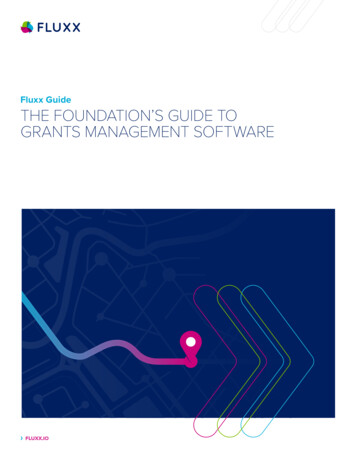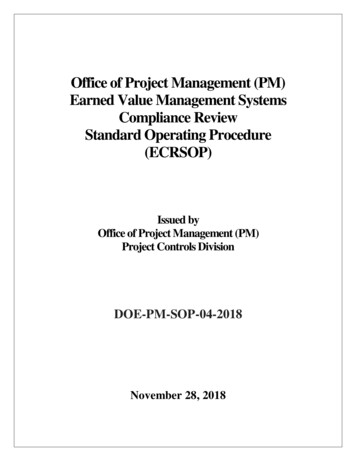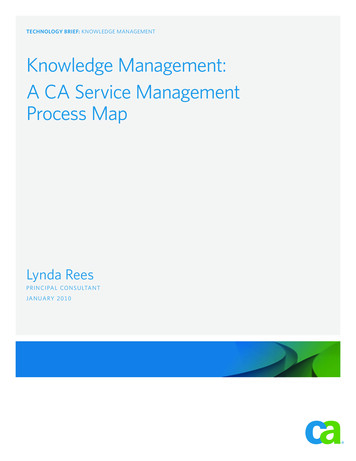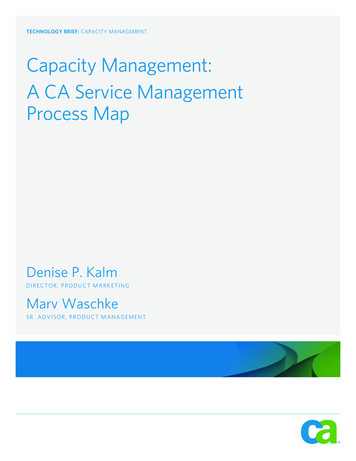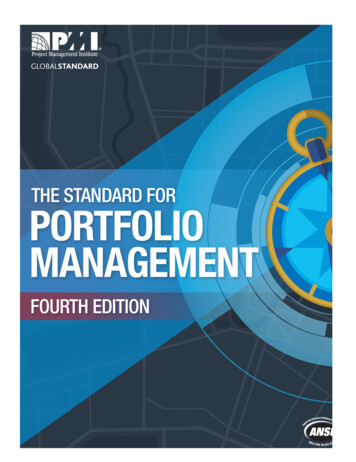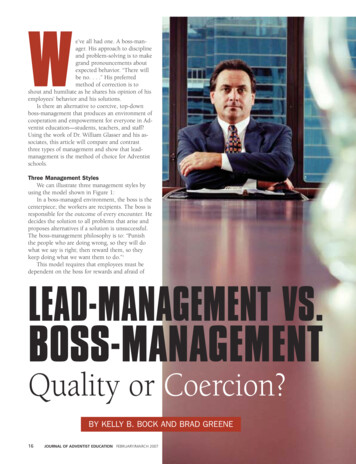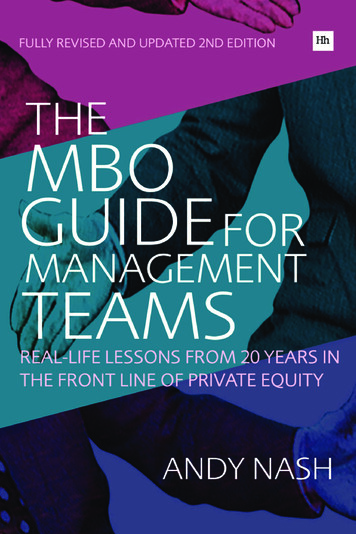
Transcription
The MBO Guide forManagement Teams
Sample www.harriman-house.com/mboguideformanagementteams
The MBO Guide forManagement TeamsReal-life lessons from 20 years in thefront line of private equityAndy Nash
For my parents Betty and Johnandto all those in leveraged buyoutsstriving to make their dreams come true
HARRIMAN HOUSE LTD3A Penns RoadPetersfieldHampshireGU32 2EWGREAT BRITAINTel: 44 (0)1730 233870Fax: 44 (0)1730 233880Email: enquiries@harriman-house.comWebsite: www.harriman-house.comFirst published in Great Britain in 2011Copyright Harriman House 2011The right of Andy Nash to be identified as the Author has been asserted inaccordance with the Copyright, Design and Patents Act 1988.ISBN: 978–1906–659–00–4British Library Cataloguing in Publication DataA CIP catalogue record for this book can be obtained from the British Library.All rights reserved; no part of this publication may be reproduced, stored in a retrievalsystem, or transmitted in any form or by any means, electronic, mechanical,photocopying, recording, or otherwise without the prior written permission of thePublisher. This book may not be lent, resold, hired out or otherwise disposed of byway of trade in any form of binding or cover other than that in which it is published,without the prior written consent of the Publisher.No responsibility for loss occasioned to any person or corporate body acting orrefraining to act as a result of reading material in this book can be accepted by thePublisher, by the Author, or by the employer(s) of the Author.Images copyright iStockphoto.comFigure data and information copyright respective owners and sourcesFinal figure design and presentation copyright Harriman House LtdSet in Minion, League Gothic and HelveticaNeue.Printed and bound in the UK by CPI Antony Rowe.
ContentsAcknowledgementsAbout the AuthorForewordxxixiiiIntroduction11. The Market and Some Basic Principles3The private equity marketWhy do a deal?Are you sure you really want to do a deal?How does an MBO/MBI work?How many deals are done in the UK?2. Finding a DealHow opportunities ariseSources of MBOs/MBIsPrivate companiesPublic companiesResearchMarketing phase3. Getting in Shape for the DealThe Eight PsA strong and united management team4. Doing the Deal – a White Knuckle RideAdvisors: assembling your teamAuction-busting!Highlights and stages of the six- to nine-month MBO/MBI processElephant traps to avoid5. Board Structure and BehaviourGood board/bad boardChairman and non-executive directorsInvestor relations6. Running an MBO/MBIWhat's changed? Mind your four CsHit the ground runningPost-completion prioritiesGetting organised: the key areas to focus uponUnique 37072757778798082vii
e MBO Guide for Management Teams Andy Nash7. Success or FailureThe 64,000 question: what are your chances of success?Common causes of underperformance: what are they?Main drivers of success in MBOs/MBIsThe work-out situation85878993958. The MBO/MBI Scorecard1079. Real Deals117Scorecard resultsTaunton Cider LtdTubex LtdMaybridge plcWebbs Country Foods LtdCloverleaf Group LtdAshford Colour Press LtdDennis Eagle LtdICA LtdThe History Press LtdTristar Worldwide LtdIntercontinental Brands Ltd10. The ExitDesires of managementManagement: realising cash from the exitInvestor needs and expectationsImportance of timingPrerequisitesExit timing – what is realistic?Exit valueTypes of exitAdvisorsManagement's tax planning11. After the ExitCorporate issuesPersonal Options12. 12 Golden Rules for Management TeamsMarket conditions and ed Reading231Appendix235Example analysis – Taunton CiderIndexviii237245
ContentsList of figures and tablesFigure 1.1: UK private equity performanceFigure 1.2: Trends of buyouts/buy-ins, 1979–2010Figure 1.3: Number of UK buyouts and buy-ins, 1985–2010Figure 1.4: MBOs and MBIs as percentage of UK takeover activity, 1991–2010Figure 1.5: Average value of buyouts/buy-ins ( m), 1990–2010Figure 1.6: Trends of above 100m buyouts/buy-ins, 1985–2010Figure 1.7: The deal funnelFigure 2.1: Sources of management buyouts/buy-ins (%), 2006–2010Figure 5.1: Example 1 of a chart in a board packFigure 5.2: Example 2 of a chart in a board packFigure 7.1: UK buyouts/buy-ins by type of exit, 1989–2010Figure 9.1: MBO/MBI scorecard for Taunton CiderFigure 9.2: MBO/MBI scorecard for TubexFigure 9.3: MBO/MBI scorecard for Maybridge plcFigure 9.4: MBO/MBI scorecard for Webbs Country FoodsFigure 9.5: MBO/MBI scorecard for Cloverleaf GroupFigure 9.6: MBO/MBI scorecard for Ashford Colour PressFigure 9.7: MBO/MBI scorecard for Dennis EagleFigure 9.8: MBO/MBI scorecard for ICAFigure 9.9: MBO/MBI scorecard for The History PressFigure 9.10: MBO/MBI scorecard for Tristar WorldwideFigure 9.11: MBO/MBI scorecard for ICBFigure 10.1: Exit numbers and exit values, 1985–2010Figure 10.2: UK buyouts/buy-ins by type of exit, 165169174178182190191Table 1.1: Simple MBO exampleTable 1.2: Major buyouts in 2010Table 1.3: Public-to-private buyouts/buy-ins in 2010Table 1.4: MBIs (including IBOs) above 100m in 2009Table 2.1: Public to private buyouts/buy-ins, 1985–2009Table 4.1: Stages in the MBO/MBI processTable 5.1: Tell-tale signs of good/bad boardsTable 5.2: Sample board calendarTable 6.1: Post-completion prioritiesTable 7.1: Performance 5–10% behind planTable 7.2: Performance more than 10% behind planTable 9.1: MBO/MBI scorecard for the 11 real dealsTable 10.1: UK buyout/buy-in exit status (%) by deal size and vintage year(1990–2010)Table 10.2: Major exits in 2010 (non-floats)Table 10.3: Flotations of UK buyouts/buy-ins on the London StockExchange (1998–2010)Table 10.4: Buyout/buy-in flotations in 2010Table 10.5: Main Market and AIM – summary of the main differencesTable 11.1: Personal ix
AcknowledgementsMike Wright at the CMBOR at Nottingham University for invaluable researchinformation and advice.Mike Molesworth for the Dennis Eagle Ltd story.Malcolm Howell for assistance on the Cloverleaf story.Peter Lee and Nigel Skinner for their help with the Tubex Ltd write-up.Nick Kerton for his help on Maybridge Plc.Jeff Bocan for helping out on the Ashford Colour Press Ltd section.Robin Tutty at K&L Gates for advice and information.Graham Spooner for his sage advice.Paul Burton, John Hibberd and John Swarbrick on ICB Ltd.Stuart Biles and Jane Vinson for lending a hand on The History Press section.Simon Whapshott for helping out on the deal at ICA Ltd.Dean de Beer and Damian Lane for their support on Tristar Worldwide Ltd.The team at Harriman House for their encouragement, wise counsel andfixing all my mistakes.x
About the AuthorAndy Nash is one of the most experienced andsuccessful MBO/MBI professionals in the UK. Over thepast 20 years he has worked on numerous deals –mostly as chairman – giving him broad, varied andunique experience. 11 of them are written up in thisbook, providing an invaluable inside look at leveragedbuyouts from a manager’s perspective.His private equity career began as a key member of themanagement team that bought out Taunton Cider for 72.5 million in 1991, went on to float it the followingyear for 153 million, and then sold it three years later for 280 million. Sincethen, as a portfolio chairman, he has been brought in to grapple with a stringof MBOs/MBIs in various states of financial health and has achieved asignificant number of notable corporate successes. The leveraged buyouts onhis CV have now achieved total shareholder returns in the hundreds ofmillions.During this time he has also chaired two publicly quoted companies, thedrinks company Merrydown and the security business Photo-Scan. Both weresuccessful stints, with shareholders receiving a handsome premium as thebusinesses developed profitably and attracted willing suitors.For good measure the 53-year old, who hails from Cheddon Fitzpaine inSomerset, is rather partial to the game of cricket and fits in time to bechairman of Somerset Cricket Club.If you are considering an MBO/MBI, or are presently wrestling with one, andyou think Andy may be able to help you, don’t hesitate to contact him atmbombi.guide@gmail.com.xi
ForewordChris AllnerDirector, Octopus Venturesor most management teams, the opportunity to lead or participate in amanagement buyout (MBO) of the company they work for is a once-ina-lifetime event. Not only is there the attraction of self-determination,away perhaps from an interfering or uncaring parent company, but also theopportunity to create personal wealth far greater than can be achieved as asalaried employee. However, there can often be significant risks, bothfinancial and professional. The process itself may falter, the buyout team maybe outbid by a competitor, and of course even once the deal has beenconsummated, few companies develop according to their business plan!FWhilst professional advice can always be bought, often expensively, there arefew comprehensive and well-informed guides for managers to use to helpthem from the very beginning of their MBO adventure. This book is thereforea must-read for such managers. Best of all it is written by someone who hashad firsthand involvement with a variety of MBOs – the number of deals runsinto double digits – and who has experienced all the potential highs and lows.The book provides counsel for all stages of a transaction, from leading up tocompletion of a buyout to beyond: exit and the tangible realisation of thedream. It delivers insights on how to work with all the stakeholders involved,xiii
e MBO Guide for Management Teams Andy Nashfrom the company’s core management team, to the staff, customers andsuppliers, vendors, banks and private equity investors. It’s an ultimate list of‘Do’s and Don’ts’. As a private equity investor in many buyouts, I believe itshould be compulsory reading!I have been fortunate to work with Andy on several occasions, first atBridgepoint, then Beringea and more recently at Octopus Ventures. He is anaccomplished entrepreneur, having moved on from a full-time executive roleand his own MBO to take up a successful plural existence as a professionalnon-executive director and mentor. He is someone who engages withmanagement teams and really makes a difference. His experience ranges frombuilding powerful management teams, setting long-term strategy andbuilding businesses up for an optimal sale, to more difficult issues such asnegotiating revisions to bank covenants, cost control and effectingmanagement change.In this book, Andy discusses the wide range of situations he has navigated,ranging from the sublime to the ridiculous. He spares the blushes of the VChouses which have at times put him into some virtually impossible situations,hoping that a Houdini-like miracle escape can be made. His anecdotes areextensive and provide an opportunity for management teams to learn aboutthe pitfalls, and upsides, which await them in any MBO.The book contains the kind of sound professional advice and truths that holdtrue whatever the shifts in the business landscape. Having worked in theprivate equity arena for nearly 30 years, I would have found this book usefulat many stages from the ’80s (when the term private equity was first coined)all the way to today, as we see the impact of recession on some over-gearedboom market deals.Above all, Andy’s book captures the intrinsic excitement of buying your ownbusiness and the thrills and spills that can ensue thereafter. There are manylessons about an MBO that can be learned without having to experience themfirst hand; wise participants can take advantage of the opportunity to readabout them here.Chris Allner2011xiv
Introductionhis book is aimed at prospective and existing managers of a managementbuyout or management buy-in. MBOs/MBIs are inherently risky, withthe failure rate being relatively high. This book can increase your chancesof success, by describing some common elephant traps, bad practices andrisks, and how best to avoid them. Private equity may amount to nothingmore than the least-worst form of capitalism; but in the UK it’s still the bestwealth-creation engine around. I don’t pretend to have been through the veryworst or best of what capitalism can offer, but what I have been through inprivate equity I can commend to you wholeheartedly.TMBOs/MBIs make or lose fortunes for the risk-takers because of the leverageinvolved. Leverage is the fulcrum on which these deals seesaw betweensuccess and failure. Every private equity firm’s portfolio has a range ofleveraged companies, and average returns to their investors are determinedby the balance between their star investments and those which stagnate, orgo bust. Leverage is a business-school type of word – my youngest daughterwould probably say it was cool! If your company were a car, leveraging it islike filling the boot with high explosive, and then driving off on a long journeywith your fingers crossed.Management buyouts and management buy-ins are the hi-octane part of thebusiness world. Since 2001, the most common exit for MBOs/MBIs hasn’tbeen flotation, or even trade sales, but the rather less salubrious denouementof receivership. It is a high-risk/high-reward arena. Metaphorically, anMBO/MBI is like fitting an 8 litre V12 engine into an aged VW Beetle and1
e MBO Guide for Management Teams Andy Nashexpecting it to perform much better than before. It is demanding, and notalways reasonably so. As someone once colourfully put it: a venture capitalistwould expect that if you made love nine times in a night, the baby wouldarrive in four weeks.Since 1991 I have been involved with many buyout and buy-in deals. Theydescribe an arc – from staggering success to the verge of financial oblivion;and, fortunately, back again. The deals have ranged across ver
There are some truly wonderful and elegant stories of how management teams or gifted individuals, researched, targeted, approached, negotiated, and closed the perfect deal. Some of these, within no time at all, might also have sold out and sailed off into the horizon, fulfilled and financially secure for life.
